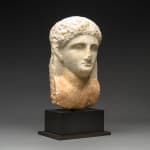Roman Marble Head of Augustus, 100 CE - 200 CE
Marble
22.2 x 12.7 cm
8 3/4 x 5 in
8 3/4 x 5 in
AM.0237
Further images
This imperial portrait head originates from one of the North African provinces of the Roman Empire. From the time of Augustus onwards the imperial family and its circle monopolised official...
This imperial portrait head originates from one of the North African provinces of the Roman Empire. From the time of Augustus onwards the imperial family and its circle monopolised official public statuary. Imperial portraits were displayed in sebasteia, or temples of the imperial cult. Along with coins, sculpture was the preferred means of disseminating the emperor’s image. Scholars believe that official portraits were created in the capital city of Rome and disseminated across the empire to serve as prototypes for local workshops. Despite this attempt at uniformity, local stylistic traits could not be suppressed and there was great regional variety across the empire.
This marble head represents the Emperor Augustus (b. 63 B.C.- d. 14 A.D.). The adopted son of Julius Caesar, Augustus’ long rule provided stability to the Empire and initiated a period of peace known as the ‘Pax Romana.’ During his reign the process of centralisation intensified and numerous other improvements were made including the rebuilding of Rome. Upon his death he was immediately deified by the Roman Senate and his cult continued to flourish until the Roman Empire accepted Christianity in the fourth century A.D. Consequently many busts and statues of Augustus were produced across the Empire.
The imperial biographer Suetonius laid great stress upon Augustus’ physical beauty. This comes across in this youthful portrait. Carved in very high relief, rather than in the round, the block of marble is visible at the level of the neck. Despite slight damage to the nose and chin, the head is in good condition and would appeal to anyone fascinated by the cult of personality during the Roman Empire.
This marble head represents the Emperor Augustus (b. 63 B.C.- d. 14 A.D.). The adopted son of Julius Caesar, Augustus’ long rule provided stability to the Empire and initiated a period of peace known as the ‘Pax Romana.’ During his reign the process of centralisation intensified and numerous other improvements were made including the rebuilding of Rome. Upon his death he was immediately deified by the Roman Senate and his cult continued to flourish until the Roman Empire accepted Christianity in the fourth century A.D. Consequently many busts and statues of Augustus were produced across the Empire.
The imperial biographer Suetonius laid great stress upon Augustus’ physical beauty. This comes across in this youthful portrait. Carved in very high relief, rather than in the round, the block of marble is visible at the level of the neck. Despite slight damage to the nose and chin, the head is in good condition and would appeal to anyone fascinated by the cult of personality during the Roman Empire.
Provenance
Gehard Kobe collectionPrivate European Collection
Acquired by Private Treaty, 2007





